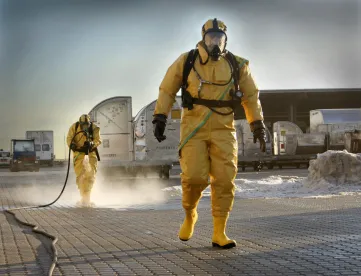On April 20, 2020, the U.S. Supreme Court issued its long-anticipated opinion in Atlantic Richfield Company v. Christian (No. 17-1498), holding that landowners whose properties are contaminated by neighboring Superfund sites may sue the parties responsible for the contamination in state court for the costs of implementing a cleanup strategy that's more stringent than the strategy selected for the site by the U.S. Environmental Protection Agency (EPA). Before pursuing a more aggressive cleanup, however, such neighboring property owners may be required to obtain EPA's approval – which EPA may or may not be willing to provide.
THE ANACONDA SITE AND NEIGHBORS’ MONTANA LAW CLAIMS
The case began in 2008 when 98 property owners in Butte, Montana sued Atlantic Richfield in a Montana trial court for "restoration damages" – costs of repairing or restoring real property damaged by another – on account of lead and arsenic from the neighboring Anaconda Copper Smelter that had contaminated soil and groundwater at their properties. Under Montana law, amounts recovered as restoration damages must actually be spent on property restoration. The Anaconda Site was one of the first federal Superfund sites, designated by EPA in 1983, and EPA had already approved a cleanup strategy before the neighbors filed their complaint. The strategy included cleanup of contaminated soil at the plaintiffs' neighboring properties. Atlantic Richfield, which owned the Anaconda site, was in the process of implementing the approved cleanup. The landowners, however, were dissatisfied with the EPA-approved cleanup strategy, so they sued Atlantic Richfield for the costs of performing a more stringent cleanup at their properties.
THE JURISDICTIONAL ISSUE – STATE LAW CLAIMS CAN PROCEED IN STATE COURT
Atlantic Richfield argued that the Montana state courts lacked jurisdiction over the landowners' lawsuit on the ground that the Comprehensive Environmental Response, Compensation, and Liability Act (CERCLA), commonly known as the federal Superfund law, grants federal courts exclusive jurisdiction over cases "arising under" CERCLA. The Montana courts rejected this argument, and Atlantic Richfield sought Supreme Court review. The Supreme Court held, 8-1, that because a suit “arises under” the law that creates the cause of action, the landowners’ common law claims for trespass, nuisance, and strict liability arose not under CERCLA, but under Montana law. Thus, CERCLA does not deprive Montana state courts of jurisdiction over those claims.
THE CONSULTATION ISSUE – THE PLAINTIFFS MUST OBTAIN EPA APPROVAL OF ADDITIONAL REMEDIATION
Chief Justice Roberts, writing for the Court, then turned to a somewhat thornier issue: under CERCLA, must EPA approve the implementation of a remedy that is more stringent – and significantly more costly – than the remedy that EPA has already approved as sufficiently protective of human health and the environment? The Montana high court had held that such additional EPA approval was not required, but on this issue the Supreme Court disagreed, relying on language in CERCLA's settlement provisions that forbids any "potentially responsible party" (PRP) at a Superfund site from undertaking a remedial action without EPA's approval once EPA or any PRP has started a remedial investigation and feasibility study, i.e., the investigation and analysis that will support the EPA's eventual remedy selection.
Atlantic Richfield, which was undoubtedly a PRP, had started the remedial investigation years before. The question, therefore, was whether the 98 landowners were also PRPs. Chief Justice Roberts, joined by all the other Justices except Justices Gorsuch and Thomas, held that they were, reasoning that CERCLA imposes liability on, among others, the current owners of a "facility"; that CERCLA defines "facilities" as places where hazardous substances have been "deposited, stored, disposed of, or placed, or otherwise come to be located"; and that arsenic and lead had in fact "come to be located" on the plaintiffs' properties. Insofar as the plaintiffs' status as PRPs was concerned, it made no difference that claims against them for recovery of costs incurred at the site were time-barred, that EPA had never notified them that they were PRPs, or that EPA had not invited them to formal settlement discussions along with Atlantic Richfield. In other words, even though no one had ever treated the plaintiffs as PRPs or tried to recover costs from them, they were still PRPs under the plain language of CERCLA, and as such they were required to obtain EPA approval before undertaking any additional remedial action on their properties that EPA had not previously authorized.
Finally, Chief Justice Roberts determined that the plaintiffs could not qualify for an exception in CERCLA to PRP status for "contiguous property owners," or "CPOs," primarily because the exception does not apply where a party acquires property with knowledge or reason to know of the contamination. In this case, the plaintiffs had clearly known, or had reason to know, about the impacts of the copper smelter on their properties before they acquired them.
IMPLICATIONS FOR CALIFORNIA AND FOR FUTURE LITIGATION
Although California, like Montana, recognizes the role of common law theories like nuisance and trespass in private party litigation regarding soil and groundwater contamination, California common law does not recognize the kind of "restoration" damages – which, if awarded, must be spent on the restoration work (i.e., additional remedial action) - that the plaintiffs in Atlantic Richfield sought under Montana law.
Nevertheless, the possibility exists in California – indeed, in every state - that owners of property impacted by migration of hazardous substances from Superfund site sources may be dissatisfied with EPA's approved remedies and may want to supplement them. In this event, the same issue regarding their status as "PRPs," and the same question whether they must obtain EPA approval that occupied the Supreme Court in Atlantic Richfield, would necessarily arise. In that respect, the key holdings in the Atlantic Richfield opinion are its finding that anyone who owns property where hazardous substances released at a Superfund site have "come to be located" could be a PRP and must seek EPA approval, and its determination that it makes no difference that such a landowner has been ignored by EPA during the Superfund process or that the landowner has a solid defense to liability for CERCLA cleanup costs. The Court's opinion also highlights the very limited reach of the CPO exception to CERCLA landowner liability, for which a property owner cannot qualify if he or she knows or has reason to know of contamination at the property at the time of acquisition. As the Court pointed out, that is a hard standard to meet when purchasing property next to a Superfund site, and it would be harder still for buyers who procure competent Phase 1 environmental site assessments – as they must in order to qualify as contiguous property owners.
In Atlantic Richfield, the plaintiffs did not claim that they qualified as "bona fide prospective purchasers" ("BFPPs") of their properties, which is another type of liability limitation that Congress added to CERCLA in 2002 when it created the CPO exemption. As a result, the decision leaves open the question—which may arise in future litigation—of whether BFPPs of properties where hazardous substances released at a Superfund site "have come to be located" would be required to seek EPA approval of remediation activities that are in addition to or inconsistent with the EPA-approved remedy. Unlike CPOs, property owners may qualify as BFPPs even if they know, or have reason to know, of the presence of hazardous substances at their properties at the time of acquisition. (As a result, BFPP status has the potential to be far more prevalent than CPO status.) However, when it created the CPO and BFPP concepts, Congress used different words to describe their status under CERCLA. A person who qualifies as a CPO "shall not be considered to be an owner or operator" – i.e., it is not a PRP in the first place, as opposed to being a PRP with a defense. By contrast, CERCLA provides that "a bona fide prospective purchaser whose potential liability for a release or threatened release is based solely on the purchaser's being considered to be an owner or operator of a facility shall not be liable as long as the bona fide prospective purchaser does not impede the performance of a response action or natural resource restoration." The BFPP provisions of CERCLA are sometimes characterized in court opinions as a "defense" to liability and at other times as a liability exemption, but the outcomes in those cases typically do not turn on that characterization. After Atlantic Richfield, the characterization of BFPP status as either an exemption from PRP status (which would excuse the qualifying landowner from seeking EPA consent to additional remedial action), or merely as a defense to liability (which would not), may determine whether an owner of property where Superfund site contamination h




 />i
/>i

